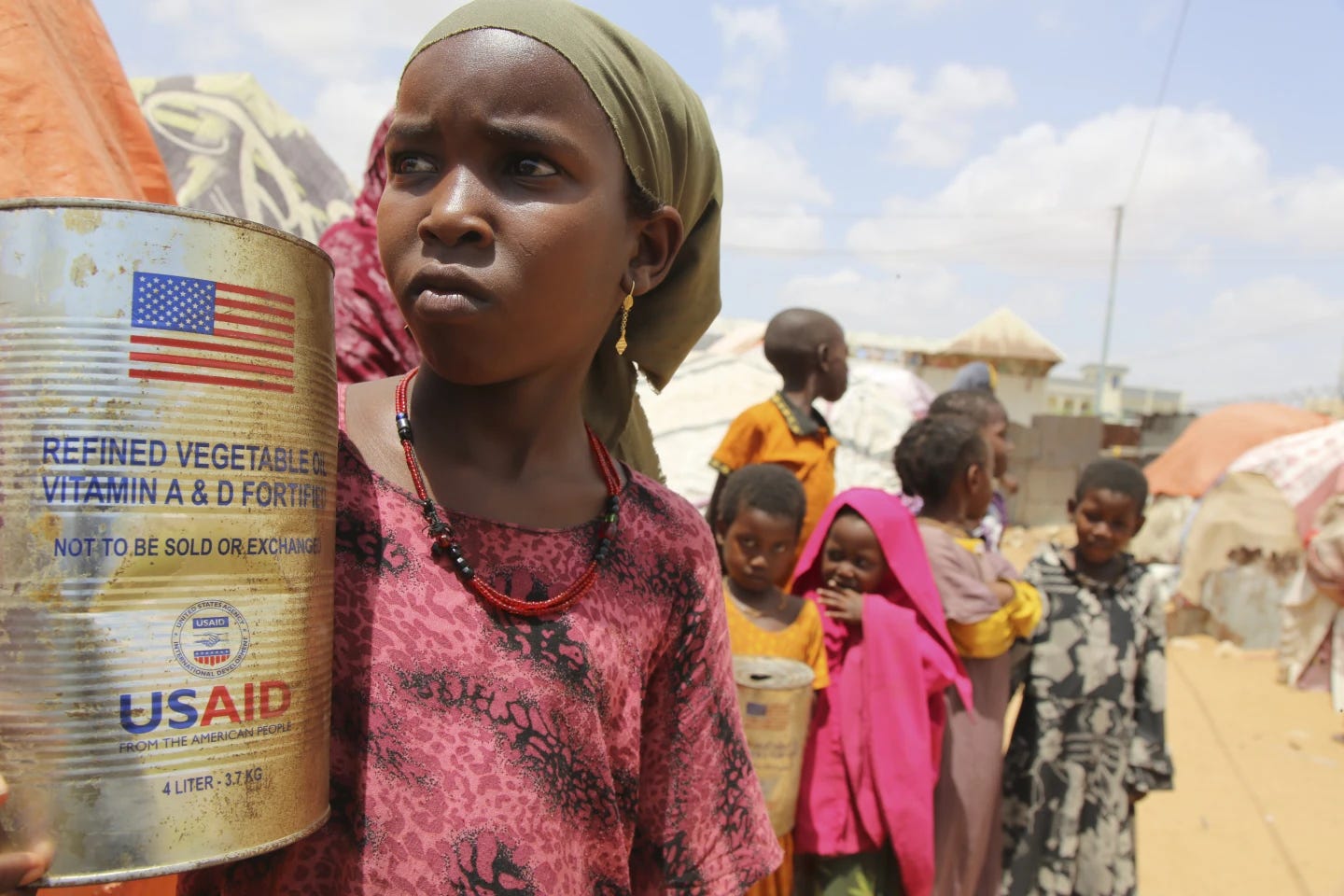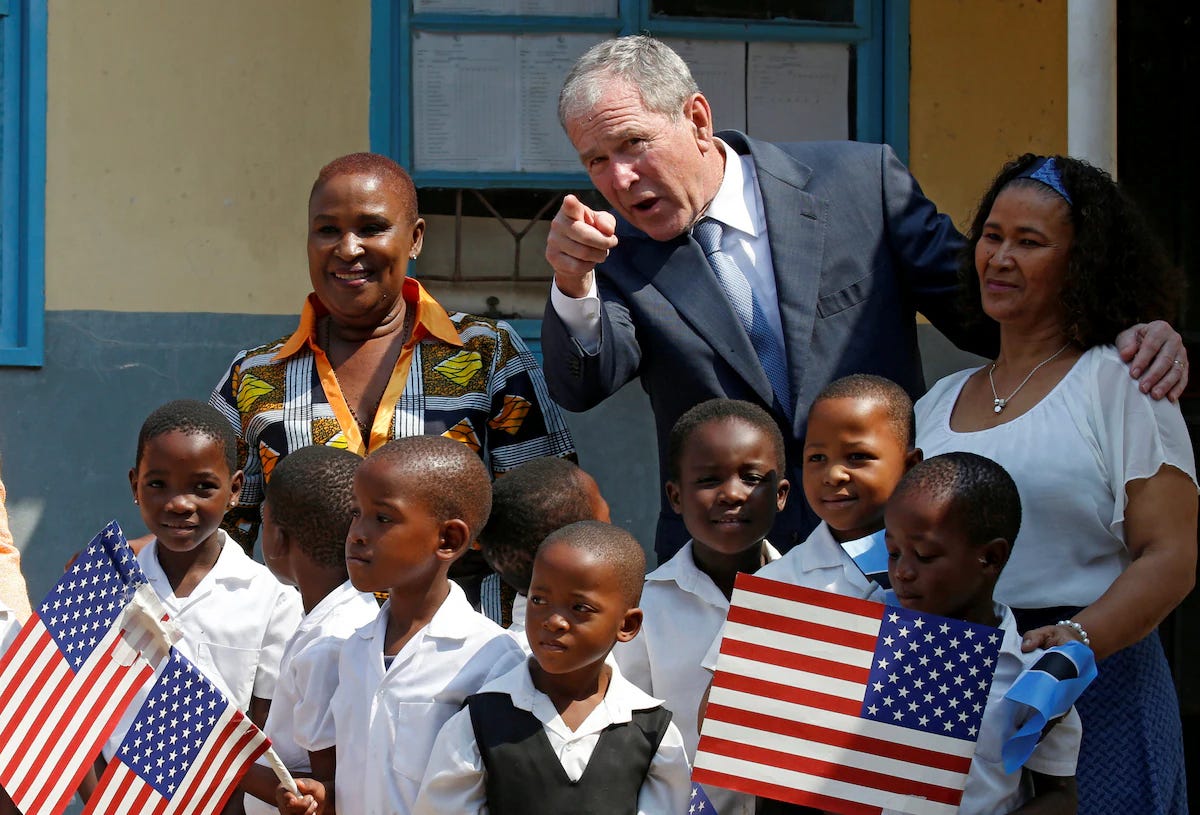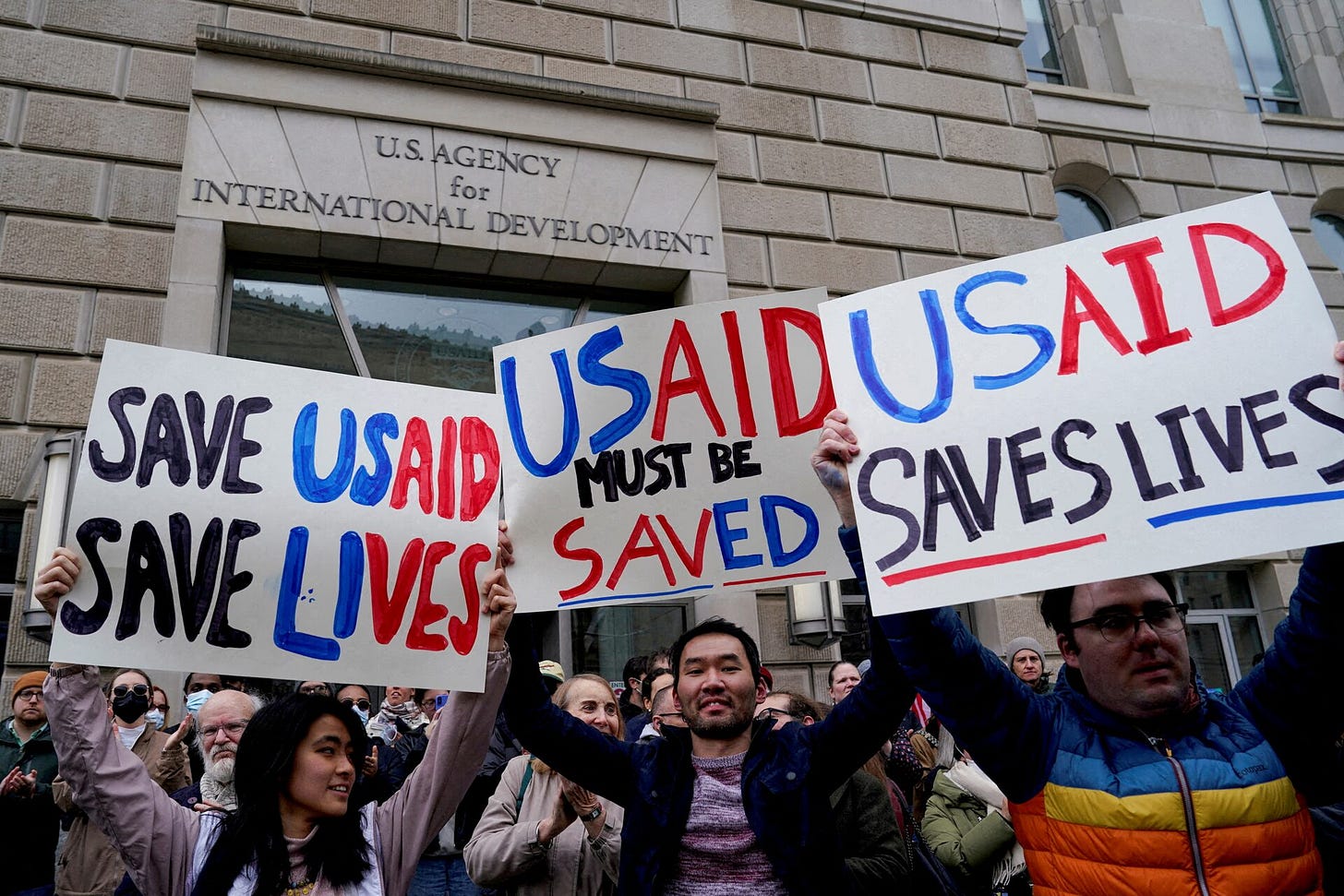Which Lives Are Worth Saving?
The small cost of helping millions
Imagine someone came to you with a pitch.
They’re crowdsourcing funding for a new miracle drug.
The drug will save 4.5 million lives per year around the world.
And they’re asking you to contribute only about 36 cents a day.
Would you take that deal?
If you pay taxes in the United States, you already did.
Except, instead of funding a wondrous new vaccine, you’ve been contributing to the US Agency for International Development, or USAID, which provides life-saving medical care around the world, as well as funding education, disaster relief, and other programs.
USAID’s budget last fiscal year was $21.7 billion. Around 165 million people pay taxes in the US, which means — if you’re one of them — you’ve been paying approximately $131 a year towards the USAID budget, or 36 cents a day.
A new study published last week in The Lancet, a medical journal, seeks to model the return you’ve been getting on your investment. The results are worth considering.
Between 2017 and 2020, the researchers report, USAID responded to more than 240 natural disasters and crises around the globe. The agency provided food assistance to more than 53 million people in a single year and funded education projects for 52 million children over four years.
All of that is easy enough to count up. But the researchers — a group of 15, hailing from the US, Spain, Mozambique, and Brazil — also wanted to see whether there was a way to calculate the number of human lives saved by USAID’s work.
They devised a model to project the impact of USAID funding in 133 countries between 2001 and 2021. Accounting for differences in factors like sanitation, the number of nurses in a country, the number of hospital beds, spending on health, and spending on education, they looked at how many people died each year in the country in reality and how many deaths would be projected if USAID funding in the country were set to zero. Then they ran the simulation 100,000 times.
What they found was impressive: 92 million additional people would have died in those two decades if USAID hadn’t existed, meaning that USAID saved about 4.5 million people per year. Thirty million of the excess deaths would have been children under five. Thirteen million would have been children in their first year of life.
High levels of USAID funding in a country were associated with a 50% reduction in deaths from tropical diseases. A 51% reduction in malaria deaths. A 65% reduction in HIV/AIDS deaths. And a 15% reduction in deaths overall.
That’s what 36 cents a day has bought you.
But no longer. Since taking office, the Trump administration has laid off 94% of USAID’s staff and canceled 83% of the agency’s grants. Last week, USAID was formally folded into the State Department.
Numerous stories have been published about the real-world impact of these cuts, from education projects shuttered in Mali to children dying of hunger in Nigeria to people being cut off from medical trials with experimental products still inside their bodies.
The researchers in The Lancet wanted to project the cumulative impact of winding down USAID programs and funding. They used their same model, entering projections for what various metrics will look like in all 133 countries for the next five years and then seeing how mortality would look without USAID funding.
They found that the gutting of USAID could lead to 14 million additional deaths through 2030, including 4.5 million additional deaths among children under five.
In other words, a new trade-off starts to emerge. The US government would save 0.3% of its annual budget. And 14 million people could lose their lives as a result.
President Trump has spoken repeatedly about waste, fraud, and abuse at USAID, and those problems undoubtedly existed to some degree in the agency, as they do everywhere.
But, seen in the Lancet researchers’ terms, USAID begins to look incredibly cost-effective, saving millions of lives for a relatively tiny price.
One of USAID’s most effective programs has been the President’s Emergency Plan for AIDS Relief, known as PEPFAR. Since its 2003 creation during the George W. Bush administration, PEPFAR has been credited with saving more than 25 million lives and preventing nearly 8 million babies from being born with HIV. Its cost is about 0.08% of the federal budget, making it “arguably the United States’ most successful foreign policy program of all time,” one expert writes, in terms of lives saved per dollar spent.
With USAID shrinking, PEPFAR’s future is up in the air. A rescissions package proposed by the Trump administration — which has already passed the House, and must pass the Senate by July 18 — would claw back $400 million from the program.
“Is it in our national interest that 25 million people who would have died now live? I think it is, and so do you,” former President Bush said in a video message last week, as USAID employees marked their last day as an independent agency. “On behalf of a grateful nation, thank you for your hard work, and God bless you.”
Meanwhile, on Substack, Secretary of State Marco Rubio wrote that USAID has had “little to show” for itself since the end of the Cold War, citing declining US approval ratings in recipient countries — but no statistics about other ways in which USAID’s work might have paid off. (He also did not dwell on other reasons why the US image may have worsened in ways that could have offset potential gains from foreign aid.)
The Lancet study fills in the holes by providing some other data about USAID’s performance. It also offers us a valuable reminder about the holes in how we assess our leaders.
We tend to measure presidencies by positive numbers: bills signed, judges nominated, dollars spent. It’s easy to add up the programs a president initiated and then assess the number of bridges they built, or factories they funded, or bombs they dropped.
For the purposes of assessing the Trump administration, that means it will be easy, for example, to analyze the affirmative impact of something like the president’s immigration agenda: we know how much money the administration is putting towards border security, and how many immigrants are being arrested as a result (more than 95,000, as of May).
But what about measuring what a president doesn’t do? It’s much harder to estimate negative numbers, calculating hypotheticals: the lives that could have been improved, or the jobs that could have been saved, or the wars that could have been averted if the president had taken an alternative route.
Since much of Trump’s agenda has been focused on cutting spending, taking stock of his legacy will be more difficult. We received an example of this just last weekend. Some experts and lawmakers have questioned whether Trump’s cuts at the National Weather Service (NWS) hobbled the agency’s ability to respond to the tragic flooding in Texas that killed more than 100 people in recent days. The administration denies this. Ultimately, we’ll never be able to see how the flood response might have played out with a fully staffed NWS. It’s an important question, but also one that is impossible to completely resolve.
Knowing exactly how many lives will be lost without USAID in the coming years is impossible, too.
As the team behind the Lancet study themselves acknowledge, there are significant limitations that make this sort of modeling difficult.
“The lack of transparency regarding the precise structure and geographic allocation of the funding cuts limits our ability to accurately predict where and to what extent the effects will materialize,” they wrote. (But the error could cut either way. It might mean 14 million deaths is an overestimate. It could also mean it’s an underestimate.)
The researchers also sought to model what would happen if USAID were completely eliminated, rather than looking at a more likely medium-case scenario: the US continues to disburse some foreign aid, but a lot less of it. (Rubio wrote that aid deemed to be “in furtherance of an America First foreign policy” will continue.)
Still, trying to model these numbers is a helpful exercise, because we so rarely judge presidencies by considering the road not traveled — what they opted not to do, not just what they did.
An academic study taking stock of USAID’s performance is also informative because it works against the coverage biases that often inflict journalists, myself included.
If the vaccine I mentioned at the beginning of this article were suddenly introduced with the promise of saving 92 million lives overnight, it would be the top headline in every newspaper.
But if a government agency saves that number of lives over a 20-year timespan simply by doing its job — just trudging along, day by day — most reporters will shrug, and most taxpayers will never hear about the return on their investment.
Conversely, if a natural disaster took place tomorrow that wiped out the entire population of Pennsylvania, or a pandemic resulted in twice the number of confirmed deaths from Covid-19, it would be a major story.
That is approximately the same impact these researchers say ending USAID would have in the next five years.
But, because the potential deaths from foreign-aid cuts would be the result of something not happening instead of a single dramatic event taking place, they’re unlikely to be reported in such an urgent way.
Studies like The Lancet’s are speculative. They’re murky. They’re dealing in hypotheticals, and their findings could end up being wrong (in either direction, of course). But, whether or not they prove 100% accurate, when conducted by well-respected academics using tested and proven methods, they deserve consideration.
And they also call for journalists (and citizens) to reconsider how we think about events — and nonevents — and how we assess world leaders accordingly.
“A person may cause evil to others not only by his actions but by his inaction, and in either case he is justly accountable to them for the injury,” the philosopher John Stuart Mill wrote in 1869.
Inaction can be a form of action. And action (or inaction) that results in a huge amount of lives saved (or lost) over a long time horizon ultimately deserves just as much attention as the sudden miracles or tragedies that generally dominate headlines.
After all, the money funding USAID is coming out of your pockets. Donald Trump is right: you deserve to know what’s being done with it. But the findings point in a very different direction than his administration claims.










Using "fraud, waste, and abuse" as a cover for the massive gutting of agencies has just been insulting - it ignores the many people and agencies who have worked for decades to specifically address the mismanagement and theft of federal funds (the rate of fraud, waste, and abuse in the public sector is far *lower* than in the private sector) and it's like saying the solution to an infection in your right pinky toe is to cut off both of your legs (because you certainly can't get an infected toe if you don't have ANY toes left). The Pentagon has never passed an audit, but the BBB gave an additional $150 BILLION toward defense spending, while stripping funds away from programs like SNAP and Medicaid, which have a fraud rate of <1% and 5% respectively and contribute significantly to the overall health (and yes, economic productivity) of our friends and neighbors. Caring about fraud, waste, and abuse means caring about investing funds in a way that maximizes the return on that investment, as Gabe so clearly laid out here.
This administration's actions betray their claims to care about fraud as a cover for simply spending that money on things they actually care about.
I work in the humanitarian field and will be the first to say there is so much room for improvement, but to claim that there is nothing to show for the last several decades of USAID is absolute rubbish. I used to feel such pride seeing the American flag with "from the American people" on hospitals, schools, pumps providing clean water, etc., and having conversations with countless health care providers, beneficiaries, community members who saw the effects this funding was having in their communities. Now being on the other end of the spectrum having to explain why we need to close malnutrition centers providing life-saving care to children under 5, defend my life's work and those delivering care in the hardest of circumstances from folks who are telling us that USAID and similar are nothing but fraud, waste and abuse is absolutely heartbreaking. I can give you many ways to make our money go farther, reduce misappropriation, and all the other aims of DOGE/this administration, but nobody is asking those who know. And this certainly was not it.